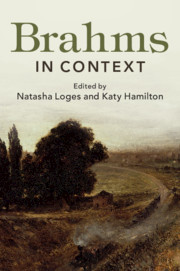Book contents
- Brahms in Context
- Brahms in Context
- Copyright page
- Dedication
- Contents
- Illustrations
- Music Examples
- Notes on Contributors
- Preface
- Abbreviations
- Part I Personality, People and Places
- Part II Identities, Environments and Influences
- Part III Performance and Publishing
- Part IV Society and Culture
- Part V Reception and Legacy
- Chapter 31 Germany
- Chapter 32 England
- Chapter 33 Analysis
- Chapter 34 The Era of National Socialism
- Chapter 35 Editing Brahms
- Chapter 36 Recordings
- Chapter 37 Historical Performance
- Chapter 38 Inspiration
- Chapter 39 Mythmaking
- Further Reading
- Index
- References
Chapter 33 - Analysis
from Part V - Reception and Legacy
Published online by Cambridge University Press: 15 May 2019
- Brahms in Context
- Brahms in Context
- Copyright page
- Dedication
- Contents
- Illustrations
- Music Examples
- Notes on Contributors
- Preface
- Abbreviations
- Part I Personality, People and Places
- Part II Identities, Environments and Influences
- Part III Performance and Publishing
- Part IV Society and Culture
- Part V Reception and Legacy
- Chapter 31 Germany
- Chapter 32 England
- Chapter 33 Analysis
- Chapter 34 The Era of National Socialism
- Chapter 35 Editing Brahms
- Chapter 36 Recordings
- Chapter 37 Historical Performance
- Chapter 38 Inspiration
- Chapter 39 Mythmaking
- Further Reading
- Index
- References
Summary
Within a decade of Brahms’s compositions first appearing in print, supporters and proponents began subjecting his music to analysis. From that time onward, commentators across the centuries have continued to scrutinise his compositions, exploring both structural elements (motifs, harmonies, counterpoint, rhythm and form) and the relationship between structure and meaning. Over time, the theoretical frameworks behind these analyses have changed, as have the broader aesthetic and scholarly environments [see Ch. 16 ‘Genre’]. Nevertheless, the origins of some of the more influential analytical approaches can be traced back to Brahms’s contemporaries. This essay will focus on the work emanating from three of the most influential theoretical schools, those inspired by Arnold Schoenberg (1874–1951), Heinrich Schenker (1868–1935) and Hugo Riemann (1849–1919).
- Type
- Chapter
- Information
- Brahms in Context , pp. 324 - 335Publisher: Cambridge University PressPrint publication year: 2019



